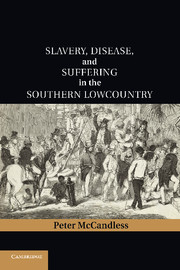Book contents
- Frontmatter
- Contents
- List of Figures
- List of Maps
- Preface
- Acknowledgments
- List of Abbreviations Used in Notes
- MAP 1 The Lowcountry, Charleston, and the Caribbean region
- MAP 2 The South Carolina lowcountry, showing Anglican parishes and slave proportion of population, c. 1760s
- MAP 3 Charleston Harbor, based on a British map, c. 1780
- MAP 4 The Revolutionary War in the South
- PART I TALK ABOUT SUFFERING
- 1 Rhetoric and Reality
- 2 From Paradise to Hospital
- 3 “A Scene of Diseases”
- 4 Wooden Horse
- 5 Revolutionary Fever
- 6 Strangers' Disease
- 7 “A Merciful Provision of the Creator”
- PART II COMBATING PESTILENCE
- Bibliography
- Index
- References
5 - Revolutionary Fever
Published online by Cambridge University Press: 03 May 2011
- Frontmatter
- Contents
- List of Figures
- List of Maps
- Preface
- Acknowledgments
- List of Abbreviations Used in Notes
- MAP 1 The Lowcountry, Charleston, and the Caribbean region
- MAP 2 The South Carolina lowcountry, showing Anglican parishes and slave proportion of population, c. 1760s
- MAP 3 Charleston Harbor, based on a British map, c. 1780
- MAP 4 The Revolutionary War in the South
- PART I TALK ABOUT SUFFERING
- 1 Rhetoric and Reality
- 2 From Paradise to Hospital
- 3 “A Scene of Diseases”
- 4 Wooden Horse
- 5 Revolutionary Fever
- 6 Strangers' Disease
- 7 “A Merciful Provision of the Creator”
- PART II COMBATING PESTILENCE
- Bibliography
- Index
- References
Summary
What will the world say now? … They will … revive a prophecy, broached a long time before the unfortunate issue of the campaign in 1781, that the triumph of Charles Town, portended the disaster at York[town]; and that from the laurels of Camden, would be extracted the bane of the British Empire on the Continent.
“Themistocles,” A Reply to Sir Henry Clinton's Narrative, 1783… the miseries of ill health, to which all those are doomed who are to serve in those intensely hot and sickly climates, whose baneful influence is known only to those who have experienced it.
George Hanger, 1801FEVERISH CAMPAIGNS
At the beginning of the eighteenth century, John Archdale had declared that God had used disease to remove the Indians and make room for the English. During the southern campaigns of the American War for Independence, fevers proved to be an important ally of the revolutionaries. Fevers mauled both sides, but they hurt the British more. Military leaders on both sides recognized the perils of warm-weather campaigning in the southern coastal lands. That did not stop them from doing so. Revolutionary leaders mounted costly and fruitless summer campaigns against British in Florida and Georgia. Similarly, the British pursued a vigorous southern strategy in the later stages of the war. It produced their greatest victories to date but severely undermined the health of their forces and helped lead to their defeat.
- Type
- Chapter
- Information
- Slavery, Disease, and Suffering in the Southern Lowcountry , pp. 84 - 105Publisher: Cambridge University PressPrint publication year: 2011

